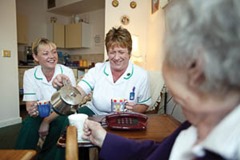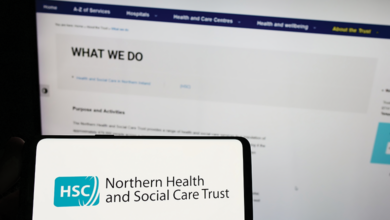Making progress on TYC
 Amid a difficult financial climate, Transforming Your Care Director Pamela McCreedy has summarised how the programme is improving life for patients and clients on the ground. Reform promises to be a long journey and strong leadership will be needed to ensure that delivery continues.
Amid a difficult financial climate, Transforming Your Care Director Pamela McCreedy has summarised how the programme is improving life for patients and clients on the ground. Reform promises to be a long journey and strong leadership will be needed to ensure that delivery continues.
Transforming Your Care (TYC) is delivering a tangible improvement in the lives of patients and is necessary to sustain the health and social care’s system over the coming years,
Pamela McCreedy has told agendaNi’s seminar on health reform.
McCreedy, the Director of TYC at the Health and Social Care Board, reflected that the reform programme is now three years old, having started with the publication of the review document in December 2011.
She recalled: “People very much advocated at the time that they wanted to be responsible citizens and encouraged us to look at how we could help to promote and assist them in making good health decisions in the first place.” The paramount aim was to enable people to live independently for as long as possible at home.
The reform agenda was, appropriately, an evolution rather than a revolution. In early 2012, the Health and Social Care Board adapted the review document to the five health and social care trust areas. A series of consultations continued into 2013 and implementation was “ramped up” in that year with the help of transitional funding to set up alternative services.
Income from the health budget is flat-lining (in real terms) and the gap between income and expenditure was set to grow by £200 million per year.
“That’s just an unsustainable service model to look at going forward,” McCreedy affirmed, “certainly not just in the current climate where we are by way of financial pressures … it’s not the right service model for individuals and for citizens of Northern Ireland.”
The early part of the reform process involved getting those services on the ground, in the primary and community care context, and getting them to work effectively before looking at what the changes would mean for a hospital setting.
Progress
Integrated care partnerships (ICPs) look at how to improve the patient’s pathways through the health and social care system from an individual’s perspective. The ICPs are using risk stratification to identify people at the greatest risk of developing a chronic condition – and therefore help to prioritise prevention and early intervention efforts. Early results from the ICPs’ work include a diabetes education programme, falls specialists to support frail elderly patients, and a home oxygen service for patients with chronic obstructive pulmonary disease.
 Reablement, which gives intensive support to older people to regain their independence after a fall, is being rolled out across Northern Ireland. Previously, they may have been discharged into a residential home or received domiciliary care.
Reablement, which gives intensive support to older people to regain their independence after a fall, is being rolled out across Northern Ireland. Previously, they may have been discharged into a residential home or received domiciliary care.
The Southern Health and Social Care Trust’s community stroke team for Newry and Mourne delivers treatment to clients for 12 weeks after their discharge from hospital. The team wanted to maximise the time they spent with people requiring care and communicates with them using Skype. For one man in Warrenpoint, this allowed him to receive three to four sessions per week at home rather than two sessions per week if he had to visit the hospital.
Meanwhile, the Northern Health and Social Care Trust has introduced renal telemonitoring whereby patients test themselves at home and clinicians view the test result: “Where there is a change in the care regime or the medication, that can be done by the individual in their own home.”
Three health and care centres are in place – in Portadown, the Holywood Arches (East Belfast) and the Grove (North Belfast) – and take referrals from smaller health centres in the surrounding area. The centres in Ballymena, Banbridge and Omagh are under construction and procurement is progressing well in Newry and Lisburn.
Services vary from area to area but can include: GP services, physiotherapy, orthopaedics, x-ray and ultrasound investigations, podiatry and social care, as well as a range of specialist GP and consultant-led clinics.
Five strategic factors have been identified as enablers for reform: finance; infrastructure; procurement; technology; and the workforce.
The financial priority was to “work within the envelope” for the year but more change was needed in 2015-2016 and beyond. The new service model, she acknowledged, would not address the whole financial challenge and there was a need for “honest conversations” about how to finance the Health Service in future.
McCreedy was pleased to see progress on primary care infrastructure. Procurement was important for delivering services on the ground while progress was slow, it was being made. She sensed a lot of enthusiasm for telemonitoring, electronic care records and other forms of new technology which could enable faster and safer decision-making. Across all service areas, the workforce will need to work and communicate in different ways.
Looking ahead, McCreedy wanted to continue to build on and implement the TYC projects. She explained: “We’re looking at how we can co-ordinate more of a system-wide reform and look at what projects we can do to deliver that across Northern Ireland.”
 The board has commissioned a review of domiciliary care to ensure that it understands the needs of population and that services are being commissioned and delivered in the right way. It is also looking at TYC’s implications for acute services. Clinical pathways need to be standardised across Northern Ireland and available in a greater number of ways.
The board has commissioned a review of domiciliary care to ensure that it understands the needs of population and that services are being commissioned and delivered in the right way. It is also looking at TYC’s implications for acute services. Clinical pathways need to be standardised across Northern Ireland and available in a greater number of ways.
Fundamental reform is “a continuous journey over many years.” It was unfair to expect a reform agenda to be fully delivered 18 months into the process. Achieving reform at scale and at pace is not easy “and we can only do that through strong leadership.” Leadership programmes had already been taken forward through the ICPs and the health and social care trusts. Change could not go forward without leadership in the system – and in the voluntary and community sectors whose help will be needed to deliver c





